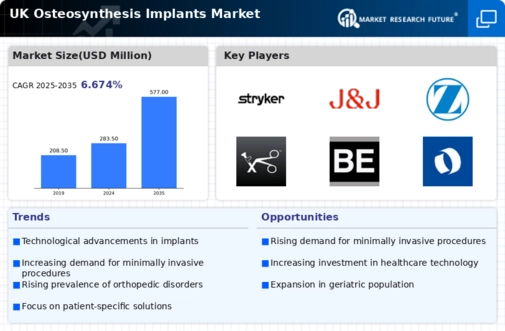Growing Geriatric Population
The growing geriatric population in the UK is a significant driver for the osteosynthesis implants market. As individuals age, they become more susceptible to fractures and other orthopaedic conditions, necessitating surgical interventions. The Office for National Statistics indicates that the proportion of individuals aged 65 and over is projected to increase by 20% by 2030. This demographic shift is likely to lead to a higher demand for osteosynthesis implants, as older patients often require surgical solutions for bone-related issues. The osteosynthesis implants market must adapt to this trend by developing implants that cater specifically to the needs of elderly patients, including considerations for biocompatibility and ease of implantation.
Rising Healthcare Expenditure
Rising healthcare expenditure in the UK is another crucial driver for the osteosynthesis implants market. The UK government has been increasing its investment in healthcare services, with a focus on improving surgical outcomes and patient care. In 2025, healthcare spending is expected to reach approximately £200 billion, reflecting a commitment to enhancing medical facilities and technologies. This increase in funding is likely to facilitate the procurement of advanced osteosynthesis implants, as hospitals seek to provide the best possible care for their patients. The osteosynthesis implants market stands to benefit from this trend, as healthcare providers are more inclined to invest in high-quality implants that promise better patient outcomes and reduced complication rates.
Advancements in Surgical Techniques
Innovations in surgical techniques are significantly influencing the osteosynthesis implants market. The adoption of advanced surgical methods, such as computer-assisted surgery and robotic-assisted procedures, enhances precision and reduces recovery times. These advancements are becoming increasingly prevalent in the UK, where hospitals are investing in state-of-the-art surgical equipment. The osteosynthesis implants market is likely to see a boost as these techniques require high-quality implants that can withstand the rigors of modern surgical practices. Additionally, the integration of 3D printing technology in implant manufacturing is expected to provide customized solutions, further driving market growth. As healthcare facilities continue to embrace these innovations, the demand for osteosynthesis implants is anticipated to rise.
Emphasis on Research and Development
An emphasis on research and development (R&D) within the medical device sector is driving innovation in the osteosynthesis implants market. UK-based companies are increasingly investing in R&D to develop new materials and designs that improve the performance of implants. This focus on innovation is crucial, as it allows for the creation of implants that are not only more effective but also safer for patients. The osteosynthesis implants market is likely to see a surge in new product launches as companies strive to meet the evolving needs of healthcare providers. Furthermore, collaborations between academic institutions and industry players are fostering advancements in implant technology, which may lead to enhanced treatment options for patients.
Increasing Incidence of Orthopaedic Injuries
The rising incidence of orthopaedic injuries in the UK is a primary driver for the osteosynthesis implants market. Factors such as an aging population, increased participation in sports, and road traffic accidents contribute to this trend. According to recent statistics, the number of hip and knee replacement surgeries has increased by approximately 10% over the past five years. This surge in surgical procedures necessitates the use of osteosynthesis implants, thereby propelling market growth. The osteosynthesis implants market is likely to benefit from this trend as healthcare providers seek effective solutions to manage these injuries. Furthermore, the demand for advanced implant technologies that enhance recovery times and improve patient outcomes is expected to rise, further stimulating market expansion.

















Leave a Comment